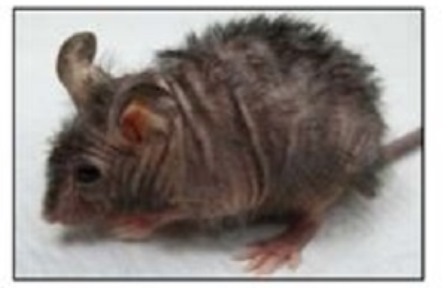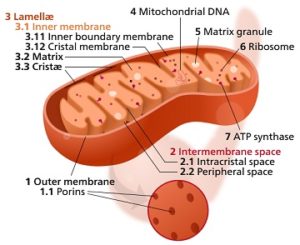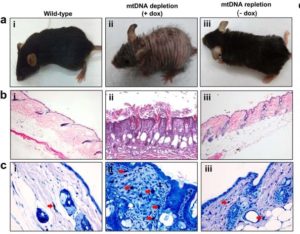
A possible model for reversing signs of aging
Wrinkled skin and hair loss are obvious features of aging-associated changes in humans. A recently published article by Singh et al. in Cell Death & Disease finds that, in mice, wrinkles and hair loss caused by a specific depletion in mitochondrial DNA (mtDNA) can be reversed by ‘turning off’ transgene expression of mutant POLG1 (a dominant-negative mutation which can induce depletion of mtDNA in tissues). Although this research is in its early stages, the importance of linking mtDNA to specific observable age-related physical attributes, and the fact that these can be reversed by restoring the mtDNA, could have wide-ranging implications in the development of treatments for age-related physical ailments and diseases.
The role of mitochondria
 Mitochondria are organelles in cells that generate cellular energy, also called the powerhouses of the cells. Mitochondrial dysfunction is associated with many mitochondrial diseases, most of which are the result of what is called dysfunctional mitochondrial oxidative phosphorylation (OXPHOS). Mitochondrial OXPHOS is the process by which cells use enzymes to oxidize nutrients and accounts for the generation of most of the cellular adenosine triphosphate (ATP) in a cell, which is a cell’s principal source of energy. A general decline in mitochondrial function has been extensively reported during aging. Furthermore, mitochondrial dysfunction (which often includes mtDNA depletion) is known to be a driving force underlying age-related human diseases such as cancer, Parkinson’s, and Alzheimer’s disease.
Mitochondria are organelles in cells that generate cellular energy, also called the powerhouses of the cells. Mitochondrial dysfunction is associated with many mitochondrial diseases, most of which are the result of what is called dysfunctional mitochondrial oxidative phosphorylation (OXPHOS). Mitochondrial OXPHOS is the process by which cells use enzymes to oxidize nutrients and accounts for the generation of most of the cellular adenosine triphosphate (ATP) in a cell, which is a cell’s principal source of energy. A general decline in mitochondrial function has been extensively reported during aging. Furthermore, mitochondrial dysfunction (which often includes mtDNA depletion) is known to be a driving force underlying age-related human diseases such as cancer, Parkinson’s, and Alzheimer’s disease.
To help define the role of mitochondrial DNA depletion in aging and various diseases, Singh et al. created a mouse in which they could turn on/off the expression of polymerase gamma (mtDNA depleter mouse), which is essential for mitochondrial function. Interestingly, skin wrinkles and visual hair loss were among the earliest and most predominant physically observable changes seen in these mice with mitochondrial dysfunction. Most intriguingly, the researchers found that if they restored the polymerase gamma function, the mitochondrial dysfunction can be reversed.

From mouse model to potential for therapeutics development
The mtDNA-depleter mouse used in this study can help rapidly identify genes and pathways that can help in better molecular understanding of mtDNA diseases. Furthermore, this animal model holds promise to generate tissue-specific modulation of mitochondrial functions to determine, for various organs, the effects of mitochondria on in vivo aging, and pathogenesis of mitochondrial depletion syndromes and other mitochondrial diseases. Together, this mouse model should provide an unprecedented opportunity for the development of preventative and therapeutic drug development strategies to augment mitochondrial functioning for the treatment of aging-associated skin and hair pathologies (eg wrinkles, hair loss, inflammation) and other human diseases in which mitochondrial dysfunction plays a significant role.
Comments